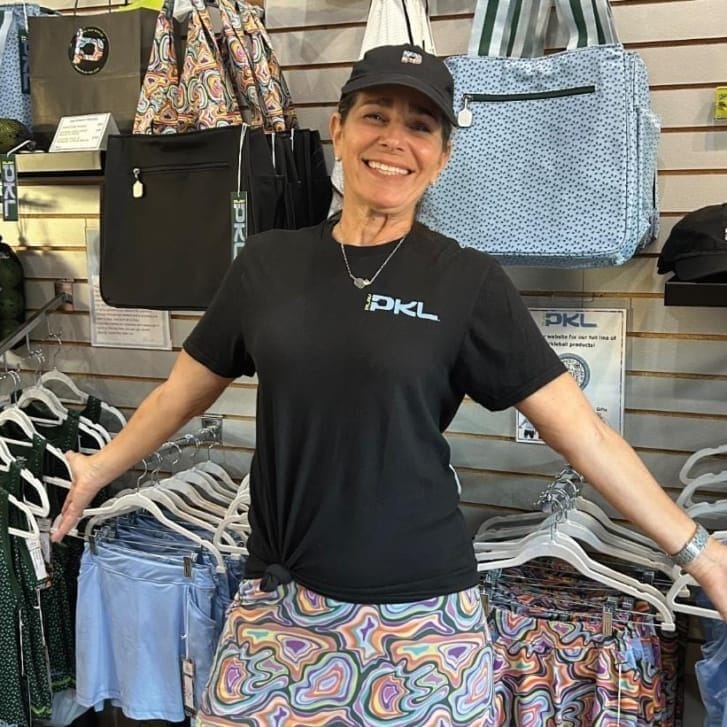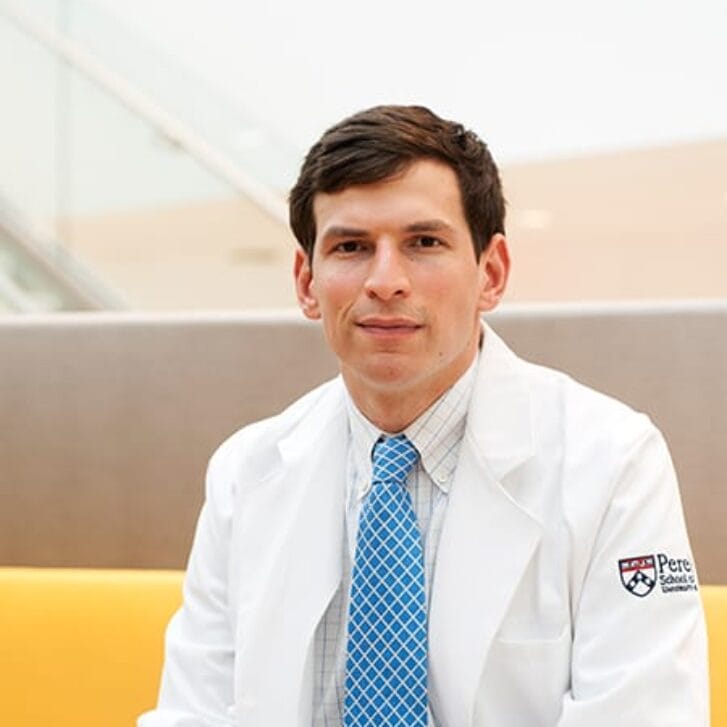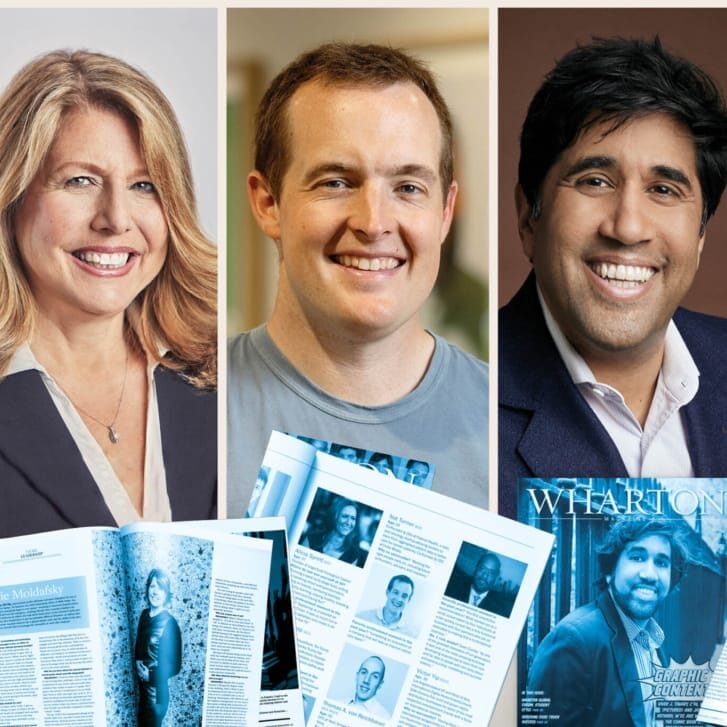Real estate is all encompassing. It’s an integral part of our internal and external lives—impacting how we live, work and thrive.
The celebrated 20th century Dutch architect Aldo van Eyck said: “Whatever space and time mean, place and occasion mean more. For space in the image of man is place, and time in the image of man is occasion.”
From Atlanta to London, Nairobi to New York City, distinguished graduates pour their hearts into building and improving communities—providing more than shelter alone to people around the world. We present their stories and accomplishments here as guiding lights to the growing numbers of students and young alumni who aspire toward social impact.
After the Storm
The motto of the Postal Service—“neither snow nor rain nor heat nor gloom of night …”—could easily apply to the real estate development work that Ron Moelis C78 W78 has undertaken.
As CEO and chairman of L+M Development Partners, Moelis has helped to reshape historic neighborhoods in New York City and New Orleans that were damaged by Hurricanes Sandy and Katrina.
L+M focuses primarily on urban development with mixed-income housing coupled with retail and commercial opportunities. Moelis says L+M has a multidisciplinary approach and operates with a double-bottom-line concept so that success isn’t just measured in terms of financial returns but “in accordance with our belief that real estate development should provide a positive benefit to the community we are developing in.”
The company is also employee-owned; this helps to rally the team to maintain L+M’s reputation with partners in government, community organizations and financial institutions, Moelis says.
For the Averne View project in the Rockaways on Long Island, the L+M team faced a daunting challenge: The team took possession of the property shortly after Hurricane Sandy hit the East Coast in late 2012. The building had been neglected for years and was one-third vacant when it was badly damaged by the rising sea. Still, L+M managed to complete a $60 million renovation, fill the building within six months and plans to maintain affordable rents for the next 30 years.
“In the end it was seen as a great example of rebuilding, maintaining affordability and creating resiliency in the face of both human neglect and natural disaster,” he says.
Moelis and his team have also helped New Orleans recover from Hurricane Katrina as partners in building a mixed-income residential development called Faubourg Lafitte, alongside a health-oriented retail concept called ReFresh. ReFresh involved the conversion of a former grocery story into a fresh food hub for community education, job training and economic recovery. ReFresh’s anchor tenant is an “urban-format” Whole Foods, surrounded by a café and commercial kitchen that teaches at-risk youth, as well as the Tulane School of Medicine Teaching Kitchen where physicians will learn how to cook, what to eat and how to help patients improve their diet and their overall health, according to L+M.
They are also gearing up to begin work on Essex Crossing, an extensive mixed-income, mixed-use development project on six acres in Manhattan’s Lower East Side that have remained largely vacant since 1967.
In addition, L+M manages two private equity funds in conjunction with Citibank and Goldman Sachs. The funds invest in real estate opportunities in the New York City metro area consistent with L+M’s mission.
Moelis says L+M remains a long-term owner of real estate not just because it makes financial sense, but because of the bond it forges “as long-term participants in the community.”
Reflecting on his Wharton experience, he says his discussions with Professor Ira Harkavy C70 GR79 (who continues to serve as associate vice president and founding director of the Barbara and Edward Netter Center for Community Partnerships) have influenced how L+M tries to integrate anchor institutions in community developments. Moelis says he never forgets his entrepreneurship class—it’s where he found his life’s calling.
City Within a City
When it comes to real estate, Jeff Blau WG92 has covered the waterfront. As CEO of Related Companies in New York City, he’s orchestrated deals for everything from very high-end projects to affordable housing.
“We truly believe you can do well by doing good,” Blau says of the firm’s work, which focuses on large-scale, mixed-use development and transit-oriented projects, among other disciplines.

There’s a common thread that’s prevalent in Related’s approach: “We invest in best-in-class design [and] sustainability initiatives and take a long view,” Blau says. Indeed, Related still owns and manages properties it developed 30 years ago. The company is currently invested in tackling a critical challenge that cities now face—the shortage of affordable and workforce housing.
“We believe that great cities have to offer housing for people of all economic walks of life,” Blau says. “It’s that diversity that gives a city its energy, and it’s really important to ensure that people who work in the cities can live in the cities.”
Related has worked with New York City to develop workforce housing for police officers, teachers and firefighters on the Queens waterfront. It’s also an integral part of Related’s most ambitious project to date.
The task at hand involves developing a city within a city, from scratch. That’s the thrill and the challenge of Hudson Yards, a 28-acre development project in New York—the largest since Rockefeller Center—that will be built upon the old rail yards of Manhattan’s west side.
“It offers us the unique opportunity to design all of our own infrastructure,” Blau says. “Everything at the yards will therefore be state-of-the-art. We are looking to make the most connected, clean, reliable, efficient and responsive neighborhood.”
A number of celebrated architects have been tapped to design office and residential buildings including A. Eugene Kohn and Bill Pederson of Kohn Pederson Fox Associates, and David Childs of Skidmore, Owings & Merrill, among others.
Half of the development—14 acres—will be public space. The heart of this will be a public square, which will house a $150 million public art installation by Thomas Heatherwick.
When it’s all completed—in about a decade—Blau plans to work and live in this futuristic village, where residents will have the ability to tap into a vast community data stream through a partnership with New York University’s Center for Urban Science and Progress.
Back in 1997, Related received a strong affirmation that it had been doing the right thing in its approach to mixed-used projects. The firm was vying to develop the Time Warner Center when thenMayor Rudolph Giuliani threatened to use his veto if developers didn’t find a home for Jazz at Lincoln Center.
“Without changing our bid, we located Jazz at Lincoln Center in some of the best real estate in the project—right on the park, on top of the retail,” Blau says. “The other bidders placed it in the back or in the basement.” The decision paid off and they won the contract.
Blau even had his foot in New York City real estate while he was enrolled at Wharton. He took classes during the first half of the week and worked at Related the second half of the week, keeping an apartment in both cities to maintain a disciplined approach to his studies and work.
The payoff has been a life that’s overflowing with real estate projects—and anchored in both worlds. Blau stays connected to Wharton by serving on the Wharton Graduate Executive Board and by keeping in close touch with mentors like Peter Linneman, now an emeritus professor of real estate at Wharton, and fellow alumni.
Community As Cornerstone
When Egbert L.J. Perry CE76 WG78 GCE79 took a serendipitous drive through Harlem in 1991 with his former Penn roommate, Clyde Gumbs W75 WG78 L79, the sojourn ended on a park bench with a career-changing question: What would it take for us to want to live and raise a family in a neighborhood?
The duo made copious notes. Perry recalls how they forged a working definition of community development that would inform his work for the next two decades: “We would provide nurturing living environments and anchor our quality-of-life infrastructure around great educational opportunities,” he says.
Ultimately, the brainstorming session led to the creation of The Integral Group, which Perry and Gumbs co-founded in 1993. As chairman and CEO of this Atlanta-based multifaceted community development, real estate development and investment management firm, he has presided over major projects throughout the U.S. He also serves as the chairman of the board of Fannie Mae, the mortgage finance giant.
Central to his mission to revitalize urban neighborhoods is Perry’s identity as an immigrant from the Eastern Caribbean islands, where he grew up in a large family—the ninth of 11 children. While his family had very little means, his parents had high expectations that their children would obtain an excellent education as a ticket to a better life.
“The community was the essence and commonality that tied us all together and bonded us to the feeling of pride and integrity that would become a cornerstone for my thought process concerning community development,” he says.
Race and class biases in many U.S. cities have defined how neighborhoods have evolved, according to Perry, “from political, social and economic redlining.”
Integral employs a straightforward community development strategy to rectify this. “We make every effort to physically and socially (re)connect these neighborhoods to the broader surrounding neighborhood and community fabric,” he says.
A case in point is the Centennial Place project in Atlanta, for which Integral served as co-general managing partner. It received national recognition for reimagining the nation’s first public housing project.
“It created the legal, regulatory and financial model for comprehensive urban revitalization—integrating mixed-income rental and ownership housing, education reform, early childhood development and a complement of other services,” Perry says.
Integral’s latest project involves transforming a former General Motors plant in Doraville, Georgia, into a 165-acre multi-use community.
Perry’s outlook was informed both by his experience living off campus in West Philadelphia and studying at Penn.
“I experienced the tension of the town-gown relationship, as well as the dynamic that played out in the Philly of the ’70s,” he says.
As a longstanding member of Penn’s Board of Trustees, Perry says he’s proud of how the University recognized its role as an anchor institution in the city and made the revitalization of West Philadelphia a critical part of its local engagement.
Perry also serves as chairman of the advisory board for the Penn Institute for Urban Research, which “furthers Penn’s commitment to its founder, Ben Franklin, by bringing together theory and practice (scholars and practitioners) in addressing issues critical to the urban agenda,” he says.
Good Will Ambassadors
Whether you’re listening to Bobby Turner W84 engage in a spirited dialogue with celebrities like Andre Agassi, Earvin “Magic” Johnson, Eva Longoria and Ashton Kutcher on campus as part of the Lauren & Bobby Turner Social Impact Executive Speaker Series, or having a one-on-one conversation, he wins you over with his infectious energy and passion for making real estate a catalyst for change.
Turner, the founder and CEO of Turner Impact Capital in Los Angeles, says he started this mission-driven real estate investment management firm in 2014 to focus on the “significant shortage of affordable, quality, community-serving infrastructure and related services in underserved communities across the U.S.”
He employs a holistic approach to triple-bottom-line investing—a strategy focused on providing sound financial returns for investors, fostering opportunities for residents of the communities in which it invests and embracing environmental responsibility.
“In society, there’s a huge mismatch between supply and demand of things like community-serving retail, high-performing public schools, affordable workforce housing, [and] job creation in densely populated, ethnically diverse communities,” he says.
Turner’s vision of socially impactful real estate is one that “seeks to revitalize a community by providing much needed services and amenities—not to regentrify it, which typically involves the displacement of the existing residents.”
He began implementing this vision during the 23 years he was chairman and CEO of Canyon Capital Realty Advisors, during which time he was responsible for launching several funds that helped define the triple-bottom-line investment movement.
Let the numbers speak for his track record: over $2.5 billion raised in equity capital, $6 billion facilitated in social impact investing, strong risk-adjusted financial returns for investors, 10,000 jobs generated, millions of square feet built of affordable workforce housing and retail, and over 50,000 school seats filled by at-risk kids.
Turner has had the flair and pull to accomplish these infrastructure redevelopment feats in some cases with celebrity activists. Instances include the Turner-Agassi Charter School Facilities Fund, focusing on the development of learning friendly, environmentally responsible charter school facilities. His partnership with Johnson (Canyon-Johnson Urban Funds) began in 2001 and focused on inner-city retail and workforce housing. For his latest project (the Turner Multifamily Impact Fund), he’s collaborating with Eva Longoria to provide quality, affordable workforce rental housing in close proximity to employment, education and health care resources.
“This is a severely supply-constrained market that’s experiencing historically low vacancy rates and a lack of affordability for half of U.S. renter households who are paying more than 35 percent of their income on rent,” Turner says.
Making headway in this space also requires getting institutional investors and philanthropists on board—a battle Turner has to wage every day.
“The biggest impediment to social investing really is capital,” he says. “Slowly and surely, institutional capital is recognizing that investing in social impact can actually generate superior risk-adjusted returns when compared to traditional value-added or opportunistic investment strategies.”
Turner says it doesn’t hurt to have “ambassadors of great will” like Johnson, Agassi and Longoria in his corner to convince investors to expand their definition of success and the value of their impact on society.
It also doesn’t hurt to have friends among the Wharton network.
“While most schools teach you that the three most important things in real estate are location, location, location, in my experience that’s not correct,” he says. “Rather, the three most important things in real estate are relationships, relationships, relationships, and the relationships I made at Wharton with my classmates and professors continue to prove invaluable.”
Microfinance Writ Large
When it comes to real estate, Rosalind Copisarow G88 WG88 has a global point of view. With decades of experience in investment banking, microfinance, and impact investing and entrepreneurship, she continues to blaze a trail—from her base in London—to help improve the lives of those excluded from traditional financial services.
From the outset of her career, Copisarow’s Wharton experience helped fuel this mission. She credits Wharton with giving her the tools to apply “a rigorous business mindset to social issues.” And as a fellow at the Lauder Institute (she now serves as a member of its advisory council), she internalized the Institute’s “pioneering focus on understanding the local culture and applying that understanding to local business approaches, practices and communication” to become an effective leader in any corner of the world.
Many readers may know of Copisarow from her efforts with the Microfinance Centre for Central and Eastern Europe (MFC), which she founded in 1997—investing $2,000 of her own money into this nonprofit foundation with the goal of sharing best practices across many countries. Today, hundreds of microfinance organizations have benefitted from MFC’s assistance.
“The number of very-low-income people who now have access to mainstream financial services, and as a result are well on their way out of poverty, is estimated at well over 30 million,” she says.
More recently in 2009, Copisarow founded the social enterprise Constellation Properties in Nairobi, Kenya, to employ what she calls a “bottom-up, demand-driven, customer-centric approach” to real estate.
Constellation helped slum tenants become homeowners of a rentable property that could initially be used as an incomegenerating asset before the actual homeowners moved into it. The firm also worked with architects and manufacturers to reconfigure a house into modular, self-assembly kits, which could be purchased separately so that the house could grow incrementally. And Constellation replaced mortgage financing with microenterprise loans, repayable within a year from income generated from the initial tenants or neighbors using the kit’s facilities, such as electricity or drinking water.
“Over the past 20 years, my work has been dedicated to enabling very-low-income households in developing countries to escape from poverty and build financial security and resilience for themselves and their communities,” Copisarow says.
Today, she’s continuing her effective work by creating a dedicated financial services platform for African diaspora communities in the U.K. Although London is home to millions of foreign nationals, the banking sector hasn’t caught up with this reality, she says. Nor has the value of their remittances been recognized as being far better targeted and monitored aid than any funding from government and foundation sources. For this reason, Copisarow also teamed with an advocacy group to launch a RemitAid scheme to potentially offer charitable tax relief on these remittances.
Copisarow says she’s heartened by some of the trends in the global marketplace that are narrowing the gap between the for-profit and nonprofit worlds, such as the increase in “interdisciplinary, multistakeholder thinking, in order to create holistic, viable solutions to complex challenges.”
She says these changes could help ameliorate the housing conditions for the more than 1 billion people living in slums worldwide.
That would be a great return on investment for her and other Wharton alumni investing in the Earth and the communities growing upon it.
—Joshua Brockman is a multimedia journalist whose stories on business, technology and the arts have been published by NPR, The New York Times and Smithsonian.


























